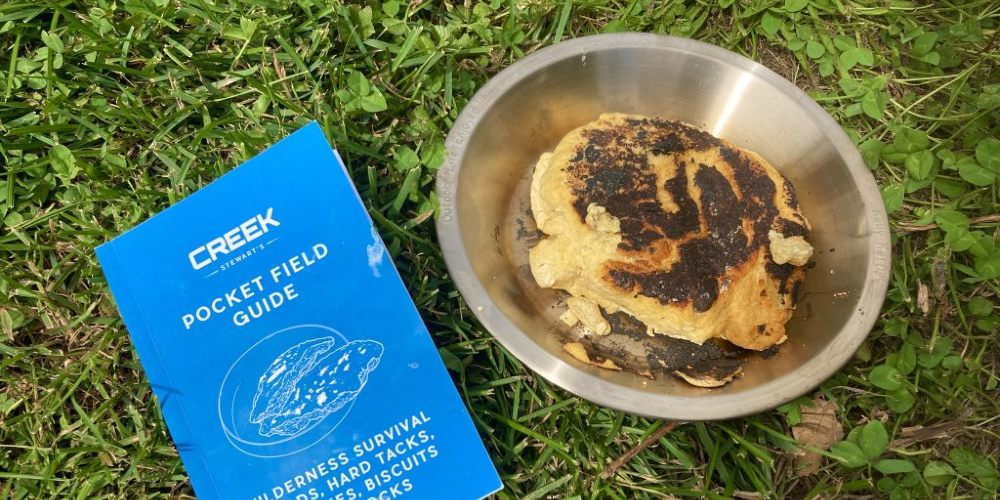In The Seven Pillars of Wisdom, Lawrence of Arabia notes that by switching to carrying flour rather than rice in their packs, his men were able to carry much more calories with them. Preppers have a special affinity for rice, but are there better options out there for long-term bug-out situations? We’ve talked about this briefly in the past before, discussing non-traditional BOB foods, but what does that look like in practice?
If you incorporate flour into your BOB, how do you use it out in the woods?
Here are two means of using your flour while out in the wild I thought you might be able to glean something from.
I’ll start by saying that neither of these recipes is my own. I totally stole them from Creek Stewart of “Fat Guys in the Woods” (one of my favorite shows when it aired). He highlights these recipes in his field manual that we’d discussed in the top non-military field manuals post.
How to make stick bread (you’ll need a stick).
This is my favorite recipe of Creek’s. Why? Because it’s as simple as it gets. I don’t really follow his recipes to the letter, so this is my simple spin on stick bread.
I pack in a Ziploc sandwich bag full of flour. I put the Ziploc bag inside of another Ziploc bag to eliminate spills. Opening up your dry bag after a full hike at dinner time only to discover that there’s flour all over your MREs everywhere is a disheartening experience. That extra Ziploc is your insurance plan.
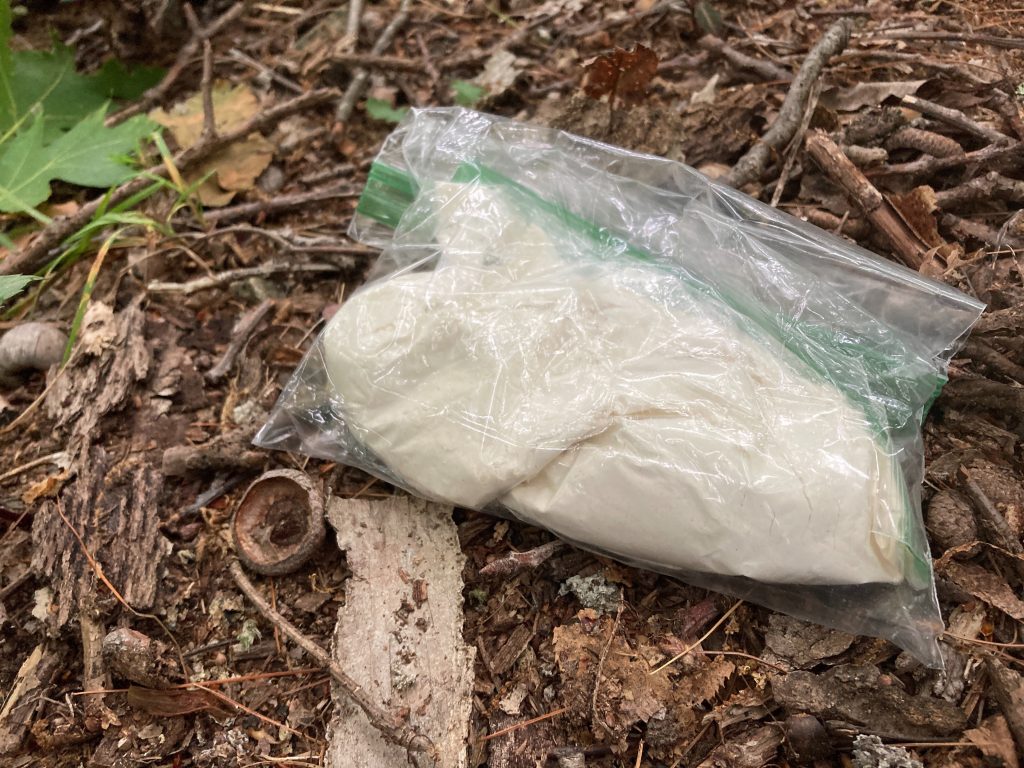
When setup time comes, I build a twiggy fire. That’s just a small campfire. There’s not a lot of signature with a twiggy fire, so if you’re concerned about that, this should help to ease your mind. You can always bake in the daytime if a light signature is a concern of yours as well.
I’m using a Kelly Kettle Hobo Stove in these pictures.
What I do is open up my Ziploc bag, pour in a bit of water until I end up with a dough mixture, and then Play-doh roll a snake/blob and put it on a stick that I’ve carved the bark off of. (My understanding here is that there are some sticks you shouldn’t use for this, but I’m not really sure what they are. Call me foolhardy, but I’ve always just picked a stick and hoped for the best. So far, so good. You probably want to figure this out.)
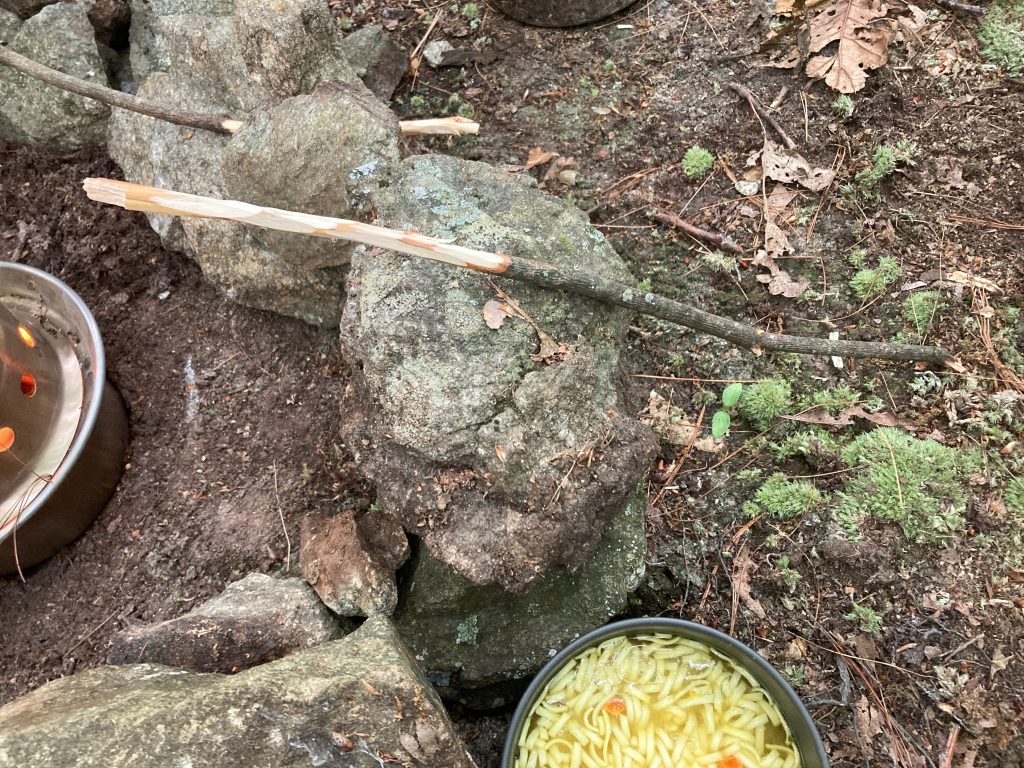
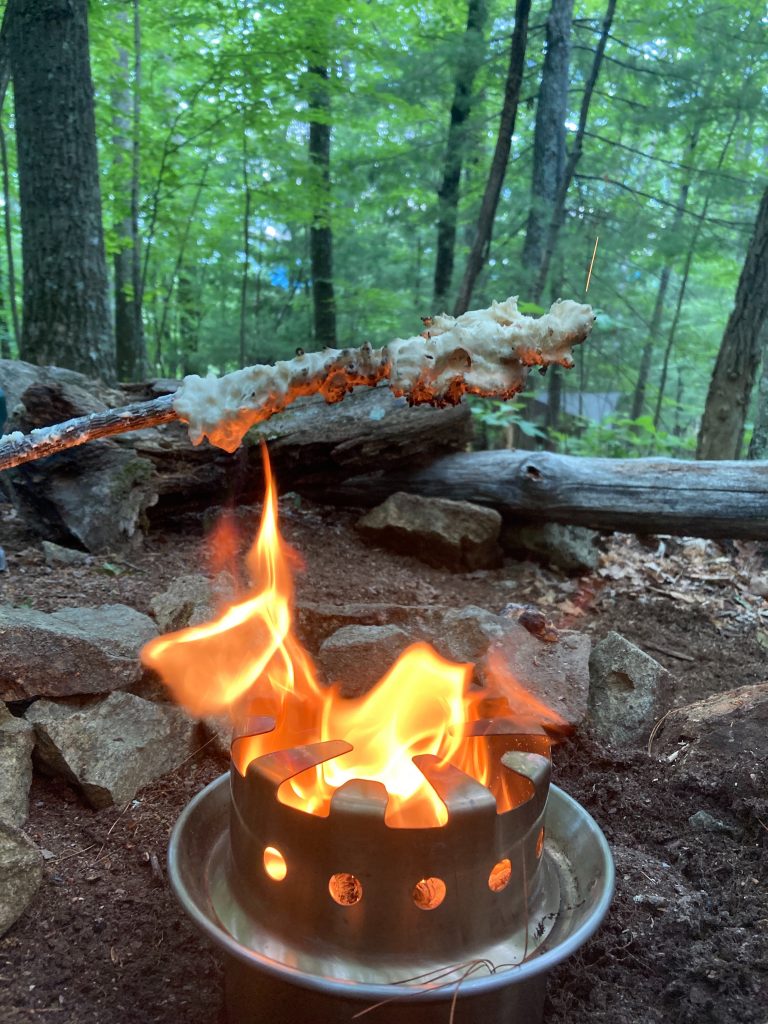
I then hold the dough-covered stick over the fire until it ends up turning into bread. Easy peezy. Creek says until golden brown, but mine always end up tinged with black.
Survival Beef on sale now. Freeze dried Ribeye, NY Strip, and Premium beef cubes. Promo code “jdr” at checkout for 25% off! Prepper All-Naturals
Your hands will be covered with sticky flour mess after this process. I get it off by rubbing my hands together until it all peels off of its own accord. I don’t like going to sleep with bears thinking I smell like a biscuit.
(Don’t starve! Read our free QUICKSTART Guide to what to eat when the power goes out.)
How to make shovel cakes
According to Creek, farmhands used to rinse off their shovels in the creek at lunchtime and then use the spade head as a form of griddle to bake bread. Around here, my shovels are largely used to remove dead critters into the woods, so there’s no way I’m doing that. Even if I heated the spade head over a fire, there’s too much of a mental block there. (“I love opossum-flavored bread!”)
I’ll note that I made this bread off-grid here in the images, but not while sleeping out in the woods as I did with the stick bread images above.
Using my same Ziploc method, I used corn meal to fashion out a little cake on a little steel plate I was using as my frying pan. You do need butter for this recipe. It tastes very bland otherwise. I doubt you’re going to be carrying butter in your BOB, but if you’re at your house when you need to make some off-grid bread, this is something to consider.
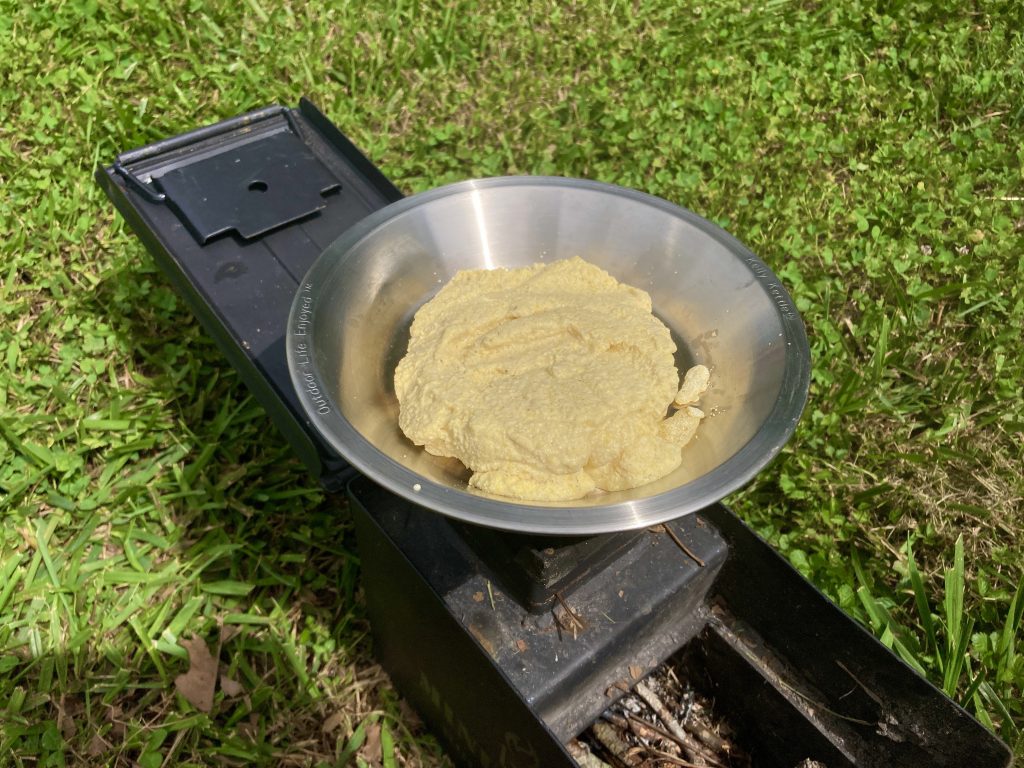
All you have to do is let the cake cook on one side until it’s tough enough to be flipped over without breaking into a bunch of pieces. Then, cook the other side for a few minutes, and you’ve made yourself a “shovel cake,” aka a big piece of cornbread.
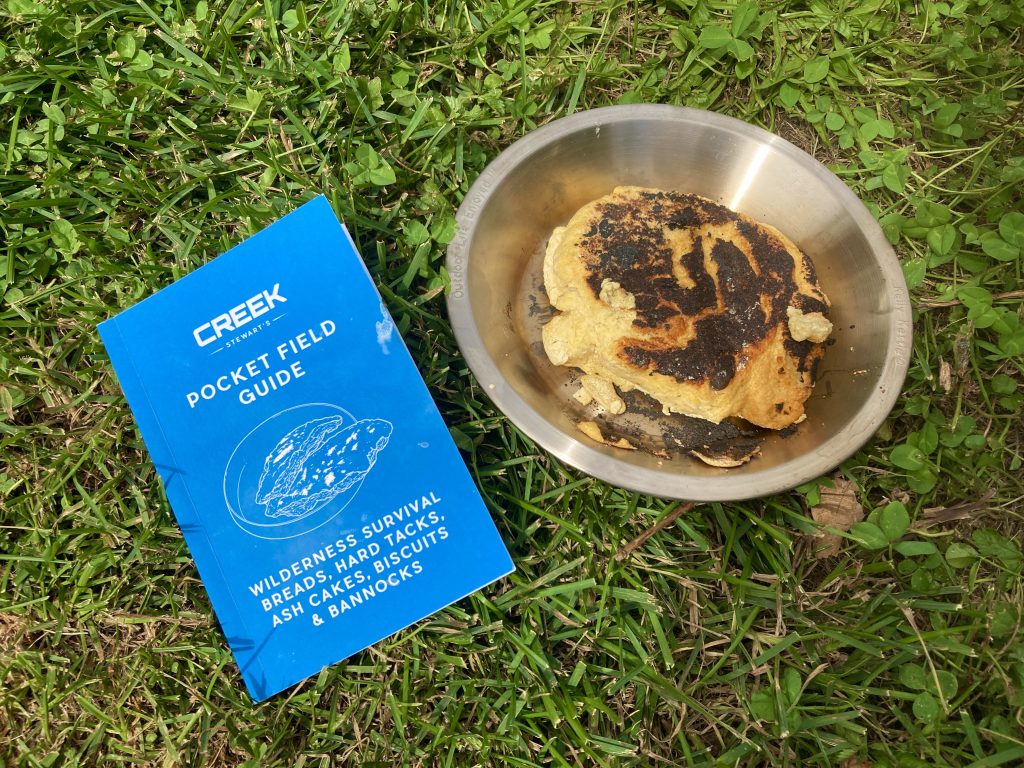
Both of these are super simple off-grid bread recipes.
Bread is fairly easy to make, even if you would never consider yourself a Martha Stewart. My version of off-grid stick bread is really nothing more than flour and water. I wouldn’t want to eat it as the main course, but it is very satisfying as a side dish while you’re out in the woods. If you’ve got more Guy Fieri flair than I do, you could easily add in whatever other ingredients and spices to make these dishes more palatable.
The stick bread could easily benefit from some type of herb, something easy enough to add to your BOB. Shovel cakes simply need butter, and they’re delicious. If you can figure out a way to get eggs with you out into the woods in one piece, you have even more options at your fingertips as well.
What are your thoughts on off-grid bread, however? Are there other recipes or methods that you can recommend? Let us know what you’re thinking in the comments below. (Also, if you’ve read Creek’s apocalyptic fiction book, let me know if it’s worth my money.)
About Aden
Aden Tate is a regular contributor to TheOrganicPrepper.com and TheFrugalite.com. Aden runs a micro-farm where he raises dairy goats, a pig, honeybees, meat chickens, laying chickens, tomatoes, mushrooms, and greens. Aden has four published books, The Faithful Prepper, An Arm and a Leg, The Prepper’s Guide to Post-Disaster Communications, and Zombie Choices. You can find his podcast The Last American on Preppers’ Broadcasting Network.
Article cross-posted from The Organic Prepper.
Five Things New “Preppers” Forget When Getting Ready for Bad Times Ahead
The preparedness community is growing faster than it has in decades. Even during peak times such as Y2K, the economic downturn of 2008, and Covid, the vast majority of Americans made sure they had plenty of toilet paper but didn’t really stockpile anything else.
Things have changed. There’s a growing anxiety in this presidential election year that has prompted more Americans to get prepared for crazy events in the future. Some of it is being driven by fearmongers, but there are valid concerns with the economy, food supply, pharmaceuticals, the energy grid, and mass rioting that have pushed average Americans into “prepper” mode.
There are degrees of preparedness. One does not have to be a full-blown “doomsday prepper” living off-grid in a secure Montana bunker in order to be ahead of the curve. In many ways, preparedness isn’t about being able to perfectly handle every conceivable situation. It’s about being less dependent on government for as long as possible. Those who have proper “preps” will not be waiting for FEMA to distribute emergency supplies to the desperate masses.
Below are five things people new to preparedness (and sometimes even those with experience) often forget as they get ready. All five are common sense notions that do not rely on doomsday in order to be useful. It may be nice to own a tank during the apocalypse but there’s not much you can do with it until things get really crazy. The recommendations below can have places in the lives of average Americans whether doomsday comes or not.
Note: The information provided by this publication or any related communications is for informational purposes only and should not be considered as financial advice. We do not provide personalized investment, financial, or legal advice.
Secured Wealth
Whether in the bank or held in a retirement account, most Americans feel that their life’s savings is relatively secure. At least they did until the last couple of years when de-banking, geopolitical turmoil, and the threat of Central Bank Digital Currencies reared their ugly heads.
It behooves Americans to diversify their holdings. If there’s a triggering event or series of events that cripple the financial systems or devalue the U.S. Dollar, wealth can evaporate quickly. To hedge against potential turmoil, many Americans are looking in two directions: Crypto and physical precious metals.
There are huge advantages to cryptocurrencies, but there are also inherent risks because “virtual” money can become challenging to spend. Add in the push by central banks and governments to regulate or even replace cryptocurrencies with their own versions they control and the risks amplify. There’s nothing wrong with cryptocurrencies today but things can change rapidly.
As for physical precious metals, many Americans pay cash to keep plenty on hand in their safe. Rolling over or transferring retirement accounts into self-directed IRAs is also a popular option, but there are caveats. It can often take weeks or even months to get the gold and silver shipped if the owner chooses to close their account. This is why Genesis Gold Group stands out. Their relationship with the depositories allows for rapid closure and shipping, often in less than 10 days from the time the account holder makes their move. This can come in handy if things appear to be heading south.
Lots of Potable Water
One of the biggest shocks that hit new preppers is understanding how much potable water they need in order to survive. Experts claim one gallon of water per person per day is necessary. Even the most conservative estimates put it at over half-a-gallon. That means that for a family of four, they’ll need around 120 gallons of water to survive for a month if the taps turn off and the stores empty out.
Being near a fresh water source, whether it’s a river, lake, or well, is a best practice among experienced preppers. It’s necessary to have a water filter as well, even if the taps are still working. Many refuse to drink tap water even when there is no emergency. Berkey was our previous favorite but they’re under attack from regulators so the Alexapure systems are solid replacements.
For those in the city or away from fresh water sources, storage is the best option. This can be challenging because proper water storage containers take up a lot of room and are difficult to move if the need arises. For “bug in” situations, having a larger container that stores hundreds or even thousands of gallons is better than stacking 1-5 gallon containers. Unfortunately, they won’t be easily transportable and they can cost a lot to install.
Water is critical. If chaos erupts and water infrastructure is compromised, having a large backup supply can be lifesaving.
Pharmaceuticals and Medical Supplies
There are multiple threats specific to the medical supply chain. With Chinese and Indian imports accounting for over 90% of pharmaceutical ingredients in the United States, deteriorating relations could make it impossible to get the medicines and antibiotics many of us need.
Stocking up many prescription medications can be hard. Doctors generally do not like to prescribe large batches of drugs even if they are shelf-stable for extended periods of time. It is a best practice to ask your doctor if they can prescribe a larger amount. Today, some are sympathetic to concerns about pharmacies running out or becoming inaccessible. Tell them your concerns. It’s worth a shot. The worst they can do is say no.
If your doctor is unwilling to help you stock up on medicines, then Jase Medical is a good alternative. Through telehealth, they can prescribe daily meds or antibiotics that are shipped to your door. As proponents of medical freedom, they empathize with those who want to have enough medical supplies on hand in case things go wrong.
Energy Sources
The vast majority of Americans are locked into the grid. This has proven to be a massive liability when the grid goes down. Unfortunately, there are no inexpensive remedies.
Those living off-grid had to either spend a lot of money or effort (or both) to get their alternative energy sources like solar set up. For those who do not want to go so far, it’s still a best practice to have backup power sources. Diesel generators and portable solar panels are the two most popular, and while they’re not inexpensive they are not out of reach of most Americans who are concerned about being without power for extended periods of time.
Natural gas is another necessity for many, but that’s far more challenging to replace. Having alternatives for heating and cooking that can be powered if gas and electric grids go down is important. Have a backup for items that require power such as manual can openers. If you’re stuck eating canned foods for a while and all you have is an electric opener, you’ll have problems.
Don’t Forget the Protein
When most think about “prepping,” they think about their food supply. More Americans are turning to gardening and homesteading as ways to produce their own food. Others are working with local farmers and ranchers to purchase directly from the sources. This is a good idea whether doomsday comes or not, but it’s particularly important if the food supply chain is broken.
Most grocery stores have about one to two weeks worth of food, as do most American households. Grocers rely heavily on truckers to receive their ongoing shipments. In a crisis, the current process can fail. It behooves Americans for multiple reasons to localize their food purchases as much as possible.
Long-term storage is another popular option. Canned foods, MREs, and freeze dried meals are selling out quickly even as prices rise. But one component that is conspicuously absent in shelf-stable food is high-quality protein. Most survival food companies offer low quality “protein buckets” or cans of meat, but they are often barely edible.
Prepper All-Naturals offers premium cuts of steak that have been cooked sous vide and freeze dried to give them a 25-year shelf life. They offer Ribeye, NY Strip, and Tenderloin among others.
Having buckets of beans and rice is a good start, but keeping a solid supply of high-quality protein isn’t just healthier. It can help a family maintain normalcy through crises.
Prepare Without Fear
With all the challenges we face as Americans today, it can be emotionally draining. Citizens are scared and there’s nothing irrational about their concerns. Being prepared and making lifestyle changes to secure necessities can go a long way toward overcoming the fears that plague us. We should hope and pray for the best but prepare for the worst. And if the worst does come, then knowing we did what we could to be ready for it will help us face those challenges with confidence.

